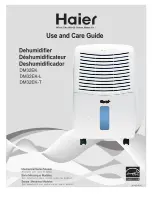
8. Operation
- 45 –
8. Operation
8. Operation
8.1
Start-up
8.1.1
Controller Se
ttings
•
Set or verify settings on the Level 1 or Level 2 Controller.
General information regarding both controllers can be
found in section 5. Detailed operational points are
presented in sections 6 and 7.
WARNING - Enclosure may have live electric parts. De-
energize dryer before opening enclosure.
•
If a Cycle or Energy (purge) Savings % change is made
while the dryer is operating, the change will occur at the
end of the current half-cycle. If it is necessary to begin a
new selection immediately, shut the unit off and then back
on. Note: A tower that is actively purging when the
power on/off button is actuated will be subjected to a
rapid repressurization that can lead to fluidization and
subsequent abrasion of the desiccant bed. Ideally,
dryers should only be powered off during those
portions of the drying cycle when both desiccant
towers are at full operating pressure.
•
If switching to a cycle mode producing a lower dew point
(e.g. 0°F to -40°F [-17.8°C to -40°C]) while the dryer is
operating, one or two days of operation may be needed
before the new dew point is achieved.
8.1.2
Initial Pressur
ization
•
SLOWLY pressurize dryer to full line pressure. (If the dryer
was installed with inlet and outlet isolation valves, the inlet
isolation valve should be slowly opened while the outlet
isolation valve remains closed.)
•
During initial start-up, check the entire system for leaks. If
necessary, de-pressurize the dryer and correct any leaks.
8.1.3
Energizing th
e Dryer
•
Energize the dryer using the power switch located on the
control panel.
•
NOTE: The switching failure alarm may be activated if the
unit is energized before it is pressurized. To deactivate
alarm, allow dryer to cycle to next step and press the reset
button.
8.1.4
Adjusting the P
urge Rate
Determine the following:
•
Maximum operating pressure (MOP) of dryer from the
dryer serial number tag.
•
Air pressure at inlet to dryer.
•
ISO Class cycle setting (Class 1, 2, 3, or 4). Note: For
units with the Level 2 Controller and the Automatic
Purge Saving System in the demand cycle mode use
the ISO Class 2 (10 min.) purge pressure settings only.
•
Energy (purge) Savings % setting. This setting is
applicable to the Level 1 Controller only.
8.1.4.1
Purge Rate P
ressure
– Models 40 to 450
•
Refer to Table 8-4 for the proper purge rate pressure
setting corresponding to the conditions listed in Section
8.1.4. Note: For units with the Level 2 Controller and
the Automatic Purge Saving System in the demand
cycle mode use the ISO Class 2 (10 min.) purge
pressure settings only.
•
Adjust purge rate valve until purge pressure gauge
indicates the required pressure. The purge pressure
adjustment valve on Models 40 through 450 is a quarter-
turn ball valve located in the smaller bypass line of the
upper piping in the rear of the dryer. Refer to Figure 4-2.
Models 40 through 450 use a double orifice purge circuit.
Equally sized orifices are located at either end of the
bypass line. The purge pressure adjustment valve, and a
pressure tap for the purge pressure gauge are piped
between the two orifices. Looking at the front of the dryer,
when the left tower is drying and the right tower is
purging, purge air flows from left to right through the first
orifice, then the purge pressure adjustment valve, past
the pressure tap for the purge pressure gauge, through
the second and final orifice and into the offline tower. The
pressure in the purge circuit just before the final orifice
controls the purge flow rate. Because the purge pressure
tap lies between the purge pressure adjustment valve and
the orifice closest to the right hand tower, the purge
pressure can only be correctly read and adjusted when
the purge flow is from left to right. This only occurs when
the right hand tower is actively purging. IMPORTANT:
Purge pressure adjustment must be made while the
RIGHT HAND TOWER AS SEEN FROM THE FRONT
OF THE UNIT is regenerating and the right hand tower
is actively purging (the purge valve associated with
the right tower is open and air is exhausting from its
muffler). Due to the symmetry of the design, identical
orifices at opposite ends and the bi-directional flow
characteristics of the purge pressure adjustment ball
valve, purge flow will be similar when towers switch and
the purge flow is from the drying tower on the right
towards the regenerating tower on the left. Purge
pressure as indicated by the purge pressure gauge
should be disregarded during this half of the operating
cycle.
•
The purge pressure adjustment valve should never be
fully closed. Proper purge flow is required to regenerate
and re-pressurize the offline tower. Should the tower fail
to re-pressurize, a switching failure alarm will be initiated,
and the cycle will be stopped before tower switch over.
•
After the purge pressure has been correctly set, the
handle of the purge pressure adjustment valve may be
removed and stored to prevent tampering with the setting.
Содержание DGH Series
Страница 12: ...4 Installation 12 4 Installation Figure 4 3 continued on next page 590 5400 SCFM General Arrangement...
Страница 22: ...6 Controller Level 1 22 6 Controller Level 1 Figure 6 2 Electrical Schematic Level 1 Controller...
Страница 23: ...6 Controller Level 1 23 6 Controller Level 1 Figure 6 3 Point to Point Connection Diagram Level 1 Controller...
Страница 24: ...6 Controller Level 1 24 6 Controller Level 1 Figure 6 4 continued on next page Panel Layouts Level 1 Controller...
Страница 39: ...7 Controller Level 2 39 7 Controller Level 2 Figure 7 2 Electrical Schematic Level 2 Controller...
Страница 42: ...7 Controller Level 2 42 7 Controller Level 2 Figure 7 4 continued on next page Panel Layout Level 2 Controller...












































